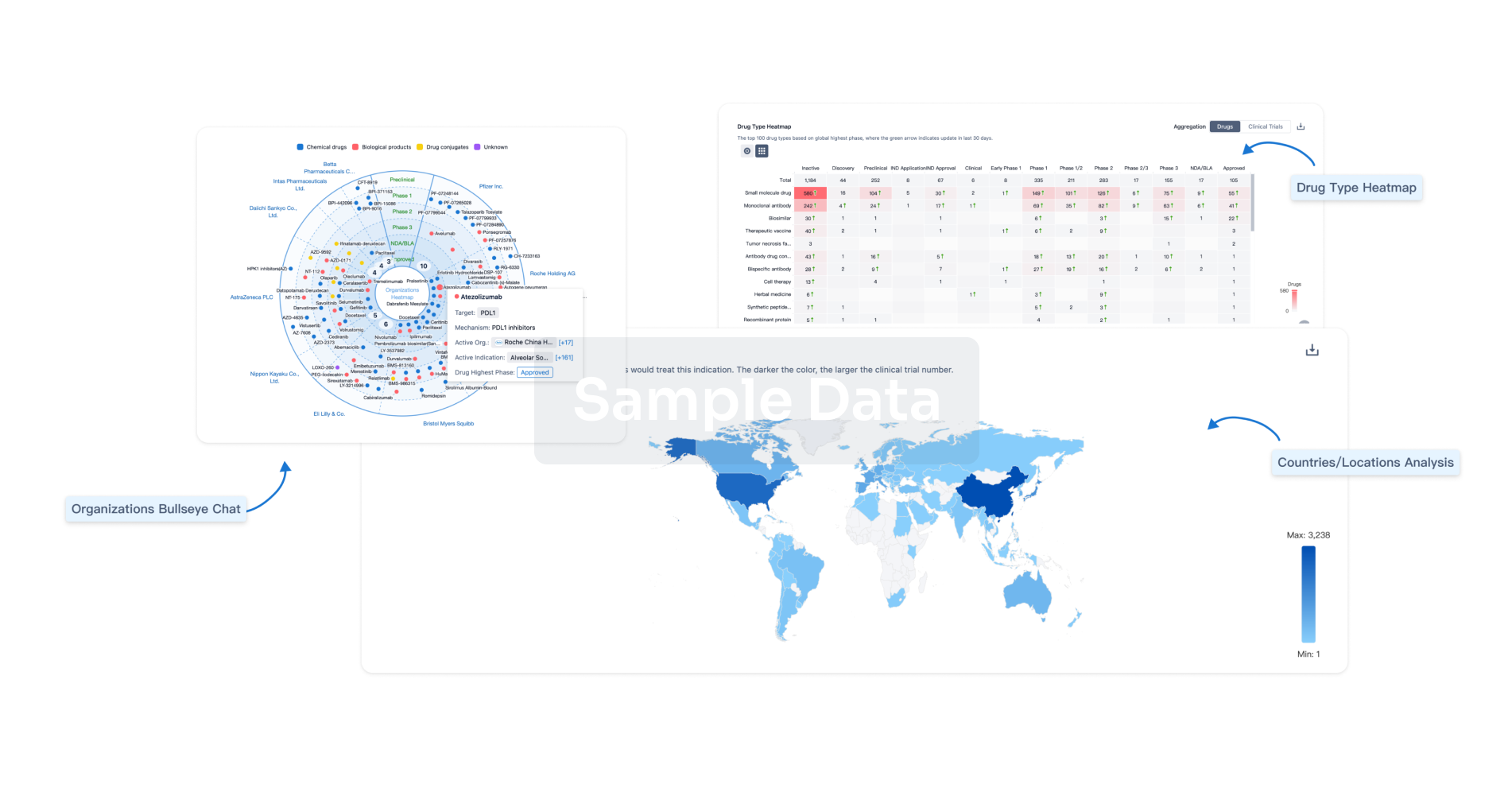Request Demo
Last update 08 May 2025
Vascular Headaches
Last update 08 May 2025
Basic Info
Synonyms Cephalgia, Vascular, Cephalgias, Vascular, HEADACHE VASCULAR + [23] |
Introduction Secondary headache disorders attributed to a variety of cranial or cervical vascular disorders, such as BRAIN ISCHEMIA; INTRACRANIAL HEMORRHAGES; and CENTRAL NERVOUS SYSTEM VASCULAR MALFORMATIONS. |
Related
6
Drugs associated with Vascular HeadachesMechanism AMPA receptor antagonists [+3] |
Active Org. |
Originator Org. |
Inactive Indication |
Drug Highest PhaseApproved |
First Approval Ctry. / Loc. United States |
First Approval Date24 Dec 1996 |
Target- |
Mechanism- |
Active Org. |
Originator Org. |
Active Indication |
Inactive Indication- |
Drug Highest PhaseApproved |
First Approval Ctry. / Loc. China |
First Approval Date01 Jan 1995 |
Target |
Mechanism 5-HT receptor antagonists |
Active Org. |
Originator Org. |
Active Indication |
Inactive Indication- |
Drug Highest PhaseApproved |
First Approval Ctry. / Loc. United Kingdom |
First Approval Date15 Mar 1974 |
15
Clinical Trials associated with Vascular HeadachesNCT04580238
Onabotulinum Toxin A (Botox) for the Treatment of Persistent Post-Stroke and Vascular Headache
Post stroke headache occurs in approximately 10-23% of all stroke patients. Its onset is shortly after experiencing a stroke, or stroke like event, and persists for at least three months. These headaches have features which resemble migraine or occur in people who have a previous history of migraine that was once infrequent. Botox is a treatment that is currently approved for the treatment of chronic migraine, that is migraine headaches occurring for at least 15 days a month for at least 3 months. Given the clinical similarity in character and frequency of post stroke headache and migraine, and the fact that stroke affects structures like the blood vessels in the brain that are also affected in migraine, this study is to investigate the possible role that Botox would have in the treatment of Post-Stroke Headache.
Start Date01 Dec 2023 |
Sponsor / Collaborator |
CTR20231424
盐酸倍他司汀片人体生物等效性研究
[Translation] Study on the bioequivalence of betahistine hydrochloride tablets in healthy volunteers
主要研究目的:研究单次空腹和餐后口服天方药业有限公司生产的盐酸倍他司汀片(8 mg)的药代动力学特征;以Mylan Laboratories SAS生产的盐酸倍他司汀片(Serc®,8 mg)为参比制剂,比较两制剂中药动学参数Cmax、AUC0-t、AUC0-∞,评价两制剂的人体生物等效性。
次要研究目的:评估受试制剂(8mg)与参比制剂盐酸倍他司汀片(Serc®,8 mg)在健康受试者的安全性。
[Translation]
The main purpose of the study is to study the pharmacokinetic characteristics of betahistine hydrochloride tablets (8 mg) produced by Tianfang Pharmaceutical Co., Ltd. after single fasting and postprandial oral administration; using betahistine hydrochloride tablets (Serc®, 8 mg) produced by Mylan Laboratories SAS as the reference preparation, the pharmacokinetic parameters Cmax, AUC0-t, and AUC0-∞ of the two preparations were compared, and the bioequivalence of the two preparations was evaluated.
Secondary purpose of the study: To evaluate the safety of the test preparation (8 mg) and the reference preparation betahistine hydrochloride tablets (Serc®, 8 mg) in healthy subjects.
Start Date09 May 2023 |
Sponsor / Collaborator |
CTR20221065
健康受试者空腹及餐后状态下口服盐酸倍他司汀片后人体生物等效性试验
[Translation] Bioequivalence study of oral betahistine hydrochloride tablets in healthy subjects in fasting and fed state
主要目的:以济南永宁制药股份有限公司生产,森淼(山东)药业有限公司持有的盐酸倍他司汀片(规格:8mg)为受试制剂,以Mylan Laboratories SAS 公司生产,Mylan Medical SAS 公司销售的盐酸倍他司汀片(商品名:Serc,规格:8mg)为参比制剂,进行空腹/餐后状态下人体生物等效性试验,评价受试制剂与参比制剂的生物等效性。次要目的:观察空腹/餐后状态下,受试制剂和参比制剂在健康受试者中的安全性。
[Translation]
Primary objective: To conduct a human bioequivalence study in the fasting/fed state using Betahistine Hydrochloride Tablets (Specification: 8 mg) produced by Jinan Yongning Pharmaceutical Co., Ltd. and owned by Senmiao (Shandong) Pharmaceutical Co., Ltd. as the test preparation and Betahistine Hydrochloride Tablets (Trade Name: Serc, Specification: 8 mg) produced by Mylan Laboratories SAS and sold by Mylan Medical SAS as the reference preparation, and to evaluate the bioequivalence of the test preparation and the reference preparation. Secondary objective: To observe the safety of the test preparation and the reference preparation in healthy subjects in the fasting/fed state.
Start Date07 Jun 2022 |
Sponsor / Collaborator |
100 Clinical Results associated with Vascular Headaches
Login to view more data
100 Translational Medicine associated with Vascular Headaches
Login to view more data
0 Patents (Medical) associated with Vascular Headaches
Login to view more data
752
Literatures (Medical) associated with Vascular Headaches01 Feb 2025·The Neuroradiology Journal
Carotidynia: Overview of an uncommon identification for unilateral neck pain
Article
Author: Ari, Buse Cagla ; Baydar, Baran ; Elgezen, Mehmet
01 Jan 2025·Anticancer Research
Vascular Pain and Nurse Burden in Peripheral Administration of Fosaprepitant/Fosnetupitant: A Prospective Observational Study
Article
Author: Sato, Yuko ; Hatakeyama, Shiro ; Kubota, Yuko ; Yoshioka, Takashi ; Ozawa, Chika ; Sawada, Hiroki ; Suzuki, Shuhei
01 Jan 2025·Canadian Journal of Infectious Diseases and Medical Microbiology
Sulbactam–Durlobactam: A Novel Antibiotic Combination for the Treatment of Acinetobacter baumannii–Calcoaceticus Complex (ABC) Hospital‐Acquired Bacterial Pneumonia and Ventilator‐Associated Bacterial Pneumonia
Review
Author: Mansour, Hanine ; Kabbara, Wissam K ; Sadek, Elina
Analysis
Perform a panoramic analysis of this field.
login
or

AI Agents Built for Biopharma Breakthroughs
Accelerate discovery. Empower decisions. Transform outcomes.
Get started for free today!
Accelerate Strategic R&D decision making with Synapse, PatSnap’s AI-powered Connected Innovation Intelligence Platform Built for Life Sciences Professionals.
Start your data trial now!
Synapse data is also accessible to external entities via APIs or data packages. Empower better decisions with the latest in pharmaceutical intelligence.
Bio
Bio Sequences Search & Analysis
Sign up for free
Chemical
Chemical Structures Search & Analysis
Sign up for free





